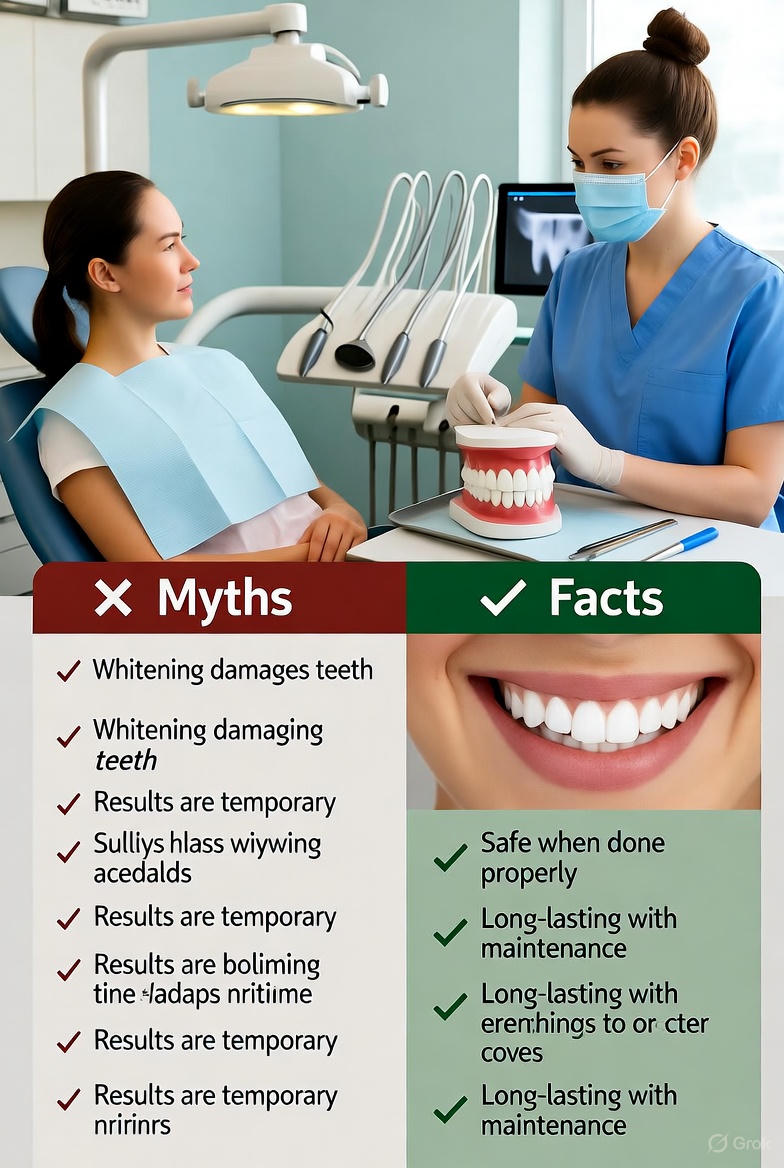A brighter smile can boost confidence, but misinformation online makes it hard to choose the right method. Below, our dental team breaks down professional vs at-home options, clears up popular myths, and shares practical tips to protect your enamel while whitening safely.
Common Teeth Whitening Myths — and the Facts
| Myth | Fact |
|---|---|
| Baking soda whitens teeth safely for daily use. | Occasional use may remove surface stains, but frequent abrasion can wear enamel and increase sensitivity. |
| Whitening permanently damages teeth. | When supervised by a dentist and used as directed, professional whitening is considered safe and enamel-friendly. |
| Charcoal toothpaste is the best natural whitener. | Highly abrasive formulas can erode enamel and worsen discoloration over time. |
| Results are instant and Hollywood-white for everyone. | Outcomes vary by stain type and shade; gradual, natural-looking improvement is healthier and more predictable. |
| At-home kits work exactly like in-office treatments. | Over-the-counter products use lower peroxide levels and non-custom trays, so results are usually milder and slower. |
Professional Whitening vs At-Home Kits
In-Office Whitening
- High-strength gels with dentist supervision
- Custom isolation to protect gums and soft tissue
- Fast, noticeable results (often in a single visit)
Best for: Quick, predictable outcomes and moderate–severe discoloration.
At-Home Options
- Dentist-made custom trays with professional gel
- OTC strips or trays with lower peroxide levels
- Gradual results over days to weeks
Best for: Budget-friendly maintenance and mild staining.
| Feature | In-Office Whitening | At-Home (Custom/OTC) |
|---|---|---|
| Speed | Fast (1–2 hours) | Slower (days–weeks) |
| Result Intensity | High | Mild–Moderate |
| Safety & Supervision | Direct dentist supervision | Self-applied (custom trays safer than OTC) |
| Cost | Higher | Lower–Moderate |
Is Whitening Right for You?
Most healthy adults can whiten safely, but a dental exam is essential. Whitening does not change the color of crowns, veneers, or fillings and may temporarily increase sensitivity. If you’re pregnant or breastfeeding, or if you have gum disease, cavities, or severe enamel wear, ask your dentist about timing and alternatives first.
- Best candidates: Extrinsic stains from coffee, tea, wine, or smoking
- May need alternatives: Intrinsic stains, fluorosis, tetracycline staining (consider veneers)
How to Maintain White Teeth
- Use a dentist-recommended whitening toothpaste 2–3x/week (non-abrasive).
- Limit staining foods/drinks (coffee, tea, red wine); sip through a straw when possible.
- Rinse with water after staining beverages; avoid smoking/vaping.
- Schedule regular cleanings every 6 months.
- Consider gentle touch-up whitening with custom trays as advised by your dentist.
Tip: If sensitivity occurs, switch to a potassium nitrate toothpaste and space whitening sessions further apart.
FAQ
Ready for a Brighter Smile?
Book a free evaluation with our dental team to find the safest and most effective whitening plan for you.
Book Your Free Evaluation